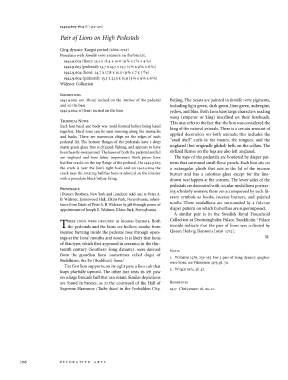Page 222 - Decorative Arts, Part II: Far Eastern Ceramics and Paintings, Persian and Indian Rugs and Carpets
P. 222
1942.9.603-604 (C-454-455)
Pair of Lions on High Pedestals
Qing dynasty, Kangxi period (1662-1722)
Porcelain with famille verte enamels on the biscuit,
1942.9.603 (lion): 25.1 x 18.4 x 10.6 (9% x 7% x 4%;)
5
3
1942.9.603 (pedestal): 13.7 x 23.7 x 15.7 (5% x 9 /i6 x 6 /6)
15
1942.9.604 (lion): 24.7 x 17.8 x 10.0 (9% x 7 x 3 /e)
x
J
1942.9.604 (pedestal): 13.3 x 23.5 x 15.9 (5 /4 x 9 /4 x 6V4)
Widener Collection
INSCRIPTIONS
1942.9.603: san (three) incised on the interior of the pedestal Beijing. The beasts are painted in famille verte pigments,
and on the base including light green, dark green, lime green, aubergine,
1942.9.604: si (four) incised on the base yellow, and blue. Both lions have large characters reading
wang (emperor or king) inscribed on their foreheads.
TECHNICAL NOTES This may refer to the fact that the lion was considered the
Each lion head and body was mold formed before being luted king of the natural animals. There is a certain amount of
together. Mold lines can be seen running along the stomachs
and backs. There are numerous chips on the edges of each applied decoration on both animals; this includes the
pedestal lid. The bottom flanges of the pedestals have a deep "snail shell" curls in the manes, the tongues, and the
matte green glaze that is chipped, flaking, and appears to have unglazed (but originally gilded) bells on the collars. The
been heavily overpainted. The bases of both the pedestal and lid stylized flames on the legs are also left unglazed.
are unglazed and have fabric impressions. Both pieces have The tops of the pedestals are bordered by diaper pat-
hairline cracks on the top flange of the pedestal. On 1942.9.603 terns that surround small floral panels. Each lion sits on
the crack is near the lion's right heel, and on 1942.9.604 the a rectangular plinth that acts as the lid of the incense
crack near the rotating ball has been reinforced on the interior burner and has a colorless glaze except for the line-
with a porcelain block before firing. drawn ruyi lappets at the corners. The lower sides of the
pedestals are decorated with circular medallions portray-
PROVENANCE ing scholarly women; these are accompanied by such lit-
(Duveen Brothers, New York and London); sold 1912 to Peter A.
B. Widener, Lynnewood Hall, Elkins Park, Pennsylvania; inheri- erary symbols as books, incense burners, and painted
tance from Estate of Peter A. B. Widener by gift through power of scrolls. These medallions are surrounded by a fish-roe
appointment of Joseph E. Widener, Elkins Park, Pennsylvania. diaper pattern on which butterflies are superimposed.
A similar pair is in the Swedish Royal Household
2
HESE LIONS WERE DESIGNED as incense burners. Both Collection at Drottningholm Palace, Stockholm. Palace
Tthe pedestals and the lions are hollow; smoke from records indicate that the pair of lions was collected by
incense burning inside the pedestal rose through open- Queen Hedvig Eleonora [1636-1715].
ings at the lions' mouths and noses. It is likely that lions SL
of this type, which first appeared in ceramics in the thir-
teenth century (Southern Song dynasty), were derived NOTES
from the guardian lions (sometimes called dogs) of 1. Williams 1976, 253-255. For a pair of Song dynasty qingbai-
Buddhism, the Fo (Buddha's) lions. 1 ware lions, see Valenstein 1975, pi. 70.
The first lion supports, on its right paw, a lion cub that
leaps playfully upward. The other lion rests its left paw 2. Wirgin 1974, pi. 47.
on a large brocade ball that can rotate. Similar depictions
are found in bronze, as in the courtyard of the Hall of REFERENCES
Supreme Harmony (Taihe dian) in the Forbidden City, 1947 Christensen: 18, 20-21.
206 D E C O R A T I V E A R T S

